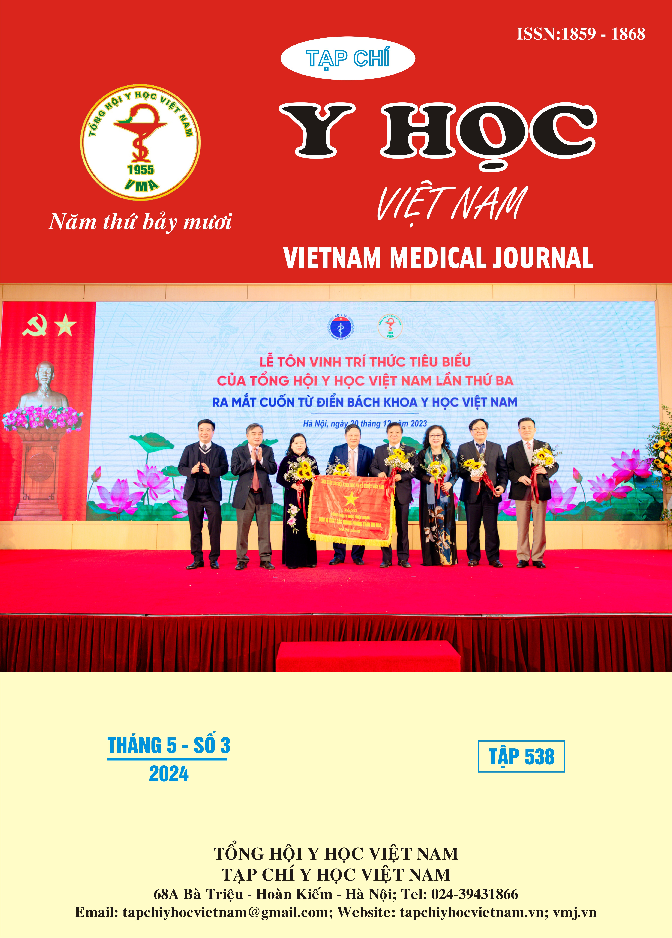ANTIBIOTIC RESISTANCE AND PRESENCE OF CTX-M-1 IN ESCHERICHIA COLI ISSUED AT CAN THO CITY GENERAL HOSPITAL
Main Article Content
Abstract
Background: Some studies show that Escherichia Coli (E.coli) bacteria is one of the typical strains with a high antibiotic resistance rate of 18-57.3% in hospitals. Objective: Surveying antibiotic resistance and the presence of the CTX-M-1 gene in E.coli bacteria isolated at Can Tho City General Hospital. Materials and methods: Cross-sectional descriptive study on 148 E.coli bacterial strains isolated at Can Tho City General Hospital from June 2023 to March 2024. Results: ICU units and pus specimens had the highest number of E.coli isolates at 31.1% and 47.3%, respectively. Up to 63.5% of E.coli bacteria belong to the super-resistant group, 34.5% belong to the multi-resistant group and 2.0% belong to the completely resistant group. 29.1% of E.coli bacteria were detected to have the CTX-M-1 gene by PCR technique. The rate of occurrence of this gene is statistically significantly related to the rate of super resistance and multi-antibiotic resistance (p < 0.05). Conclusion: E.coli strains isolated at Can Tho City General Hospital have a high prevalence of multi-antibiotic resistance and nearly 1/3 of strains were found to carry the CTX-M-1 gene..
Article Details
Keywords
Escherichia coli, ESBL, CTX-M-1.
References
2. Bradford P. A. (2001), "Extended-spectrum beta-lactamases in the 21st century: characterization, epidemiology, and detection of this important resistance threat", Clin Microbiol Rev,14 (4)933-51, table of contents.
3. Bell J. M., Turnidge J. D., Gales A. C., Pfaller M. A.&Jones R. N. (2002), "Prevalence of extended spectrum beta-lactamase (ESBL)-producing clinical isolates in the Asia-Pacific region and South Africa: regional results from SENTRY Antimicrobial Surveillance Program (1998-99)", Diagn Microbiol Infect Dis,42 (3)193-8.
4. Bontron Séverine, Poirel Laurent &Nordmann Patrice (2016), "Real-time PCR for detection of plasmid-mediated polymyxin resistance (MCR-1) from cultured bacteria and stools", Journal of Antimicrobial Chemotherapy,71 (8)2318-2320.
5. Trần Thị Mai Hưng, Dương Thị Hồng, Lương Minh Tân (2021), “Tỷ lệ Escherichia coli mang gen mã hóa sinh ESBL ở bệnh nhân mắc một số bệnh thông thường đến khám tại tuyến y tế cơ sở ở một số tỉnh, thành phố của Việt Nam”, Tạp chí Khoa học & Công nghệ Việt Nam, 63(12) 12.2021, DOI: 10.31276/VJST.63(12).19-24.
6. Võ Thái Dương (2022), Nghiên cứu tình hình đề kháng kháng sinh và sinh enzyme ESBL của Escherichia coli tại bệnh viện đa trung ương Cần Thơ năm 2021 – 2022, Luận án Thạc Sĩ, Trường Đại học Y dược Cần Thơ.
7. Quế Anh Trâm (2023). Khảo sát mức độ kháng kháng sinh của Escherichia Coli gây nhiễm khuẩnhuyết được phân lập tại Bệnh viện hữu nghị đa khoa Nghệ An (1/2021-12/2021). Tạp chí Truyền nhiễm Việt Nam, 2(38), 14-17.


